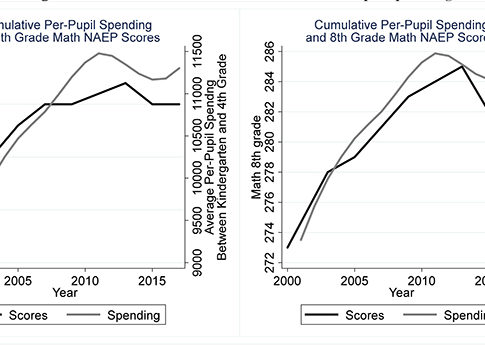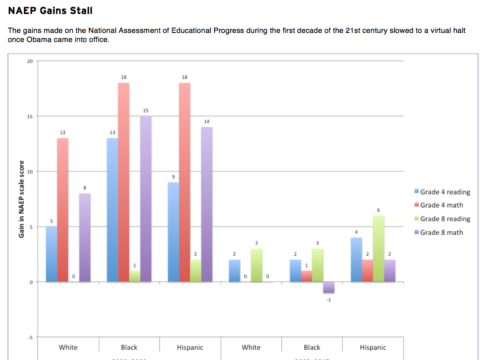The results from the 2017 National Assessment of Educational Progress (NAEP) are out. These assessments are the only assessment of student achievement that allow for comparisons across all the states, across some large school districts, across a range of subgroups, and over time. This year more caution is warranted given the change to online administration. Nonetheless, NAEP provides our best indication of national trends.
What do the new data show? In summary, very little change. The increasing scores and decreasing achievement gaps evident in the first few years of the century have leveled off. Math results are unchanged in both 4th and 8th grade, and while reading results are one point higher in 8th grade than they were in 2015, they were two points lower in 2015 than in 2013. The positive trends in scores, especially for mathematics, during the first few years of the 21st century have leveled off and the scores are roughly the same as they were a decade ago, though we haven’t lost the gains from that last boost. The changes evident for states are tempting to latch onto – no states increased their 4th grade reading but nine states saw decreases. Nonetheless, more than half of those decreasing states were among the handful of states to show progress in 4th grade reading on the last round of NAEP assessments. Some changes from year to year are not due to embedded improvement but instead to chance differences across cohorts. Those ups and downs are part of an unusually stable trend. Not only haven’t average scores improved, racial/ethnic and income gaps haven’t closed. The beginning of the century again saw a small closing of racial and ethnic achievement gaps, but over the over the last eight years NAEP shows little movement, though no increases.
Substantial stability in math and reading is the key finding from this round of assessments, but one pattern in the data is worth keeping an eye on: the spread of the achievement distribution. The gains in test performance in the early 2000s were driven by particularly strong gains for the lowest performing students. This pattern held for both 4th and 8th graders and for both reading and math. However, that trend appears to be reversing. In 2015 scores in mathematics decreased for low- and mid-performing 4th graders compared to 2013, and this year we again see a decrease for lower performers in 4th grade math, as well as in reading, while such a decrease is not evident for higher performers. Moreover, higher performers in 8th grade saw increasing scores while middle and low performers did not. This spread in achievement differences across students is not necessarily problematic. Students vary in their academic strengths. Those that falter in one area may excel in another. Yet some reading and math skills are increasingly necessary to thrive and to contribute to others. To the extent that this pattern reflects a reduced focus on low-performing students it may signal decreasing opportunity for the most struggling students to gain the skills they will need as then enter adulthood. Such a trend warrants closer inspection.
— Susanna Loeb
Susanna Loeb is the Barnett Family Professor of Education at Stanford University, faculty director of CEPA Labs, and a co-director of Policy Analysis for California Education.
This post is part of a series from Education Next analyzing the 2017 results from the National Assessment of Educational Progress. Click here to check out the series, and stay tuned throughout the week of April 10 for more analysis






